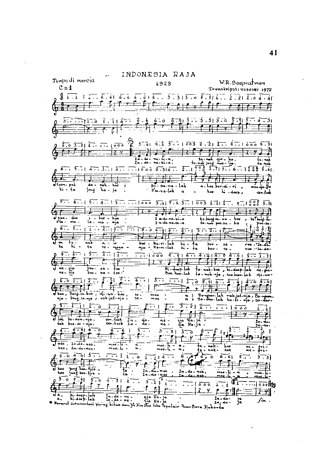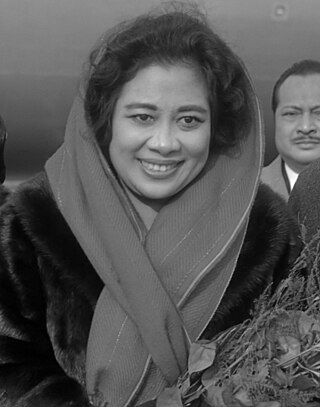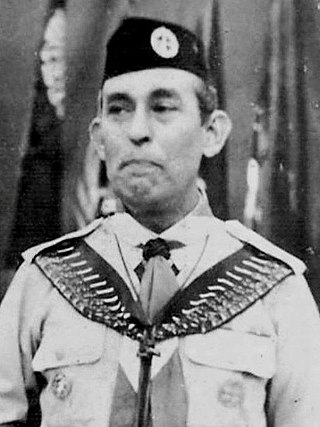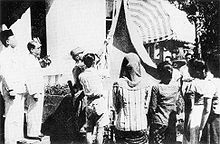
The national flag of Indonesia is a simple bicolor with two horizontal bands, red (top) and white (bottom) with an overall ratio of 2:3. It was introduced and hoisted in public during the proclamation of independence on 17 August 1945 at 56 Proklamasi Street in Jakarta, and again when the Dutch formally transferred sovereignty on 27 December 1949. The design of the flag has remained unchanged since.

"Indonesia Raya" is the national anthem of Indonesia. It has been the national anthem since the Proclamation of Indonesian Independence on 17 August 1945. The song was introduced by its composer, Wage Rudolf Supratman, on 28 October 1928 during the Youth Pledge in Jakarta. The song marked the birth of the all-archipelago nationalist movement in Indonesia that supported the idea of one single "Indonesia" as successor to the Dutch East Indies, rather than split into several colonies. The first newspaper to openly publish the musical notation and lyrics of "Indonesia Raya"—an act of defiance towards the Dutch authorities—was the Chinese Indonesian weekly Sin Po.

Sukarno was an Indonesian statesman, orator, revolutionary, and nationalist who was the first president of Indonesia, serving from 1945 to 1967.

The National Monument is a 132 m (433 ft) obelisk in the centre of Merdeka Square, Central Jakarta. It is the national monument of the Republic of Indonesia, built to commemorate the struggle for Indonesian independence.

The Morning Star flag was a flag used in Netherlands New Guinea for official purposes in addition to the flag of the Netherlands. It was first raised on 1 December 1961 prior to the territory coming under administration of the United Nations Temporary Executive Authority (UNTEA) on 1 October 1962.

The Merdeka Palace, is one of six presidential palaces in Indonesia. It is located on the north side of the Merdeka Square in Central Jakarta, Indonesia and is used as the official residence of the president of the Republic of Indonesia.

The songkok or peci or kopiah is a cap widely worn in Brunei, Indonesia, Malaysia, Singapore, the southern Philippines, and southern Thailand, most commonly among Muslim males. It has the shape of a truncated cone, usually made of black or embroidered felt, cotton or velvet. It is also worn by males in formal occasions such as weddings and funerals or festive occasions such as the Eid ul-Fitr and Eid al-Adha holidays. In Indonesia, the peci is also associated with the nationalist movement.

The Preparatory Committee for Indonesian Independence, PPKI, Japanese: 独立準備委員会, romanized: Dokuritsu Junbi Iinkai) was a body established on 7 August 1945 to prepare for the transfer of authority from the occupying Japanese to Indonesia. It approved and promulgated the first Indonesian constitution, and appointed Sukarno president.

Angkasa Pura is the name used by two separate state-owned enterprises of PT Aviasi Pariwisata Indonesia (InJourney) responsible for the management of airports in Indonesia. The two companies are PT Angkasa Pura I and PT Angkasa Pura II. Angkasa Pura I has its head office in Kemayoran, Jakarta, while Angkasa Pura II has its head office at Soekarno-Hatta International Airport in Tangerang, Banten.

Merdeka Square is a large square located in the center of Jakarta, Indonesia. Merdeka is the Indonesian word for freedom or independence. Measuring approximately one square kilometer in area, if the surrounding fields within the Merdeka Square are included, it is considered one of the largest squares in the world. At 75 hectares, it is over five times the size of Tiananmen Square, and 12 times the size of Place de la Concorde.

Fatmawati was a National Hero of Indonesia. As the inaugural First Lady of Indonesia, she was the third wife of the first president of Indonesia, Sukarno, and the mother of Indonesia's first female president, Megawati Sukarnoputri. She constructed the first flag flown by Indonesia.

The capital of the Republic of Indonesia is Jakarta, one of the oldest continuously inhabited cities in Southeast Asia. Previously known as Batavia, it was the de facto capital of the Dutch East Indies. In the early 20th century, the Dutch East Indies government attempted to relocate the capital from Batavia to Bandung. During Indonesia's struggle for independence, the Indonesian government moved the capital to Yogyakarta and then to Bukittinggi, where it remained for a short time until the restoration of control to Jakarta. In 2019, during his annual state of the union address at the parliament, President Joko Widodo announced a plan to relocate the capital to Kalimantan on the island of Borneo. As part of the plan, part of Kutai Kartanegara Regency and Penajam North Paser Regency in East Kalimantan will be carved out to create a new province-level planned city, and the capital will be relocated to a more central location within Indonesia. On 17 January 2022, the name was revealed to be Nusantara.
Jeruk Purut is a cemetery in Jakarta, Indonesia.

National symbols of Indonesia are symbols that represent Republic of Indonesia. It can represent Indonesia as a nation, Indonesian people, culture, arts, and its biodiversity. The official symbols of Indonesia are officially recognise symbols that represent Indonesia and enforced through Indonesian laws. These symbols of the state that represent Indonesian nationhood are Garuda Pancasila, Merah-Putih flag, Indonesia Raya national anthem, and Indonesian language.

Cultural properties of Indonesia are those items defined by Indonesian law as of "important value for history, science, and culture", and include both man-made artefacts and natural objects. The cultural properties number more than 8,000 and include ancient Hindu and Buddhist temples, mosques, historic colonial buildings, forts, art galleries, national parks and beaches. A number of the sites are World Heritage Sites.

The Paskibraka is a youth troop-formed organization and/or flag-raising squad in Indonesia which has the main task to escort, raise and lower the heirloom national flag of Indonesia in Independence day ceremonies commemorating the independence day of Indonesia throughout Indonesia.

Major Muhammad Husein Mutahar was the founder of Paskibraka, a youth organization in Indonesia which has the main task for raising and lowering the heirloom national flag of Indonesia in ceremonies commemorating the independence day of Indonesia. Mutahar was also an Indonesian music composer, especially for national songs and children's songs. As a composer, he was better known as H. Mutahar as his abbreviation name. In addition, as a diplomat Mutahar was once served as Indonesian ambassador to the Vatican in 1969 to 1973.

The Independence Day of Indonesia is a national holiday in Indonesia commemorating the anniversary of Indonesia's proclamation of independence on 17 August 1945. It was made a national holiday by government decree in 1946.

The Hotel Yamato incident was the tearing of the blue colour of the Dutch flag flying at Hotel Yamato on 19 September 1945, which was preceded by the failure of negotiations between negotiations between Soedirman and W. V. C. Ploegman to lower the Dutch flag.




















